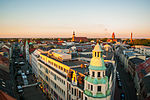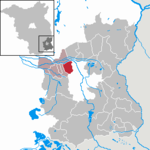Lower Sorbian Gymnasium Cottbus

Lower Sorbian Gymnasium Cottbus (Lower Sorbian: Dolnoserbski gymnazium Chóśebuz, German: Niedersorbisches Gymnasium Cottbus), is a coeducational gymnasium (e.g. preparatory high school or grammar school) in Cottbus the second-largest city in Brandenburg, Germany. It is the only high school in Lower Lusatia in which education is organized in Lower Sorbian language and the language is compulsory up to the twelfth grade. While German language is widely used as the first language by many students and professors, in May 2005 and following the 2004 enlargement of the European Union some students recognized education in the school as a good preparation for future participation in economic exchanges with neighboring West Slavic countries of Czech Republic and Poland.
Excerpt from the Wikipedia article Lower Sorbian Gymnasium Cottbus (License: CC BY-SA 3.0, Authors, Images).Lower Sorbian Gymnasium Cottbus
Seminarstraße, Cottbus - Chóśebuz
Geographical coordinates (GPS) Address Website External links Nearby Places Show on map
Geographical coordinates (GPS)
| Latitude | Longitude |
|---|---|
| N 51.769444444444 ° | E 14.331111111111 ° |
Address
Niedersorbisches Gymnasium Cottbus
Seminarstraße
03044 Cottbus - Chóśebuz (Schmellwitz)
Brandenburg, Germany
Open on Google Maps











